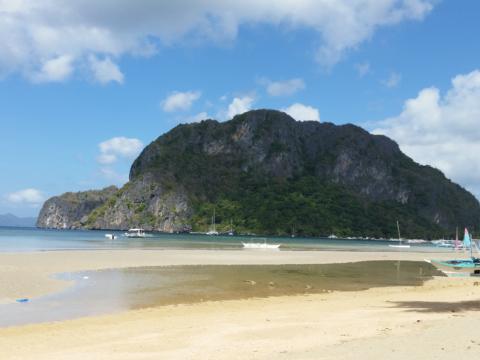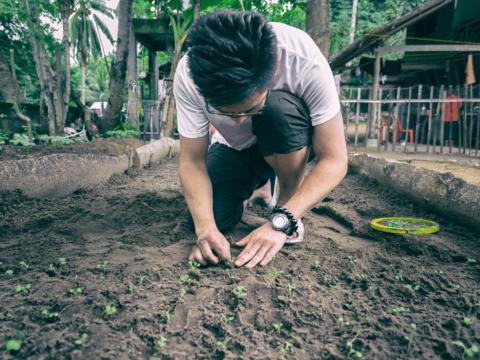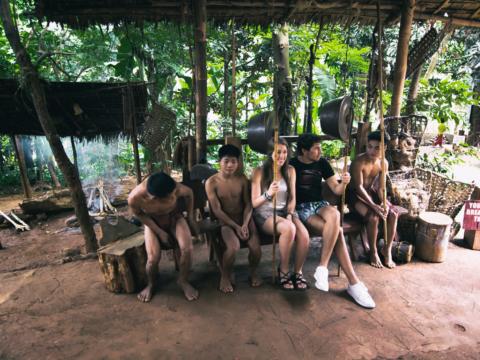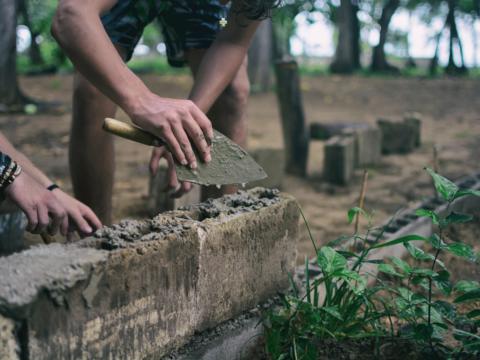Only 1,800€ per week!
Diving Course
El Nido (Palawan) - Philippines
Discover the beautiful underwater world near the shores of El Nido, Palawan and get your official PADI diving license while you’re at it!
The waters surrounding El Nido are rich with marine biodiversity which tempts divers back to this location time and time again. Underneath these pristine waters is where you will be completing your four day course and upon completion will receive the PADI Open Water Diver Certification that is recognised worldwide.
Program Description
The PADI open water course is for everybody who wishes to get their PADI open water license and discover the beautiful underwater world of El Nido. You will receive your official PADI certification one month after successfully completing the course. However, you will already be handed a temporary license to be able to continue with diving trips right away!
El Nido is one of the most beautiful and pristine places on the Island of Palawan in the Philippine Archipelago. Located on the North of this beautiful Island, El Nido is well known for its beautiful white sandy beaches, clear waters and rich biodiversity. This makes El Nido the ideal place to fulfil your PADI Open Water Diver Certification and enjoy everything that this laidback place has to offer.
The PADI open water course will take a total of 4 days from Monday to Thursday. Friday is reserved for a relaxing massage and enjoying your newly gained PADI Open Water Certificate!
Aims & Objectives
The aim of this program is to offer everyone the opportunity to get their PADI open water diving license whilst experiencing the beautiful underwater world of El Nido bay.
Schedule
Monday
Starting day of the diving course. You will watch an instructional video, take part in classes and will receive diving instructions inside the diving center.
Tuesday to Wednesday
On the Tuesday and the Wednesday the course participants will be taught how to dive closely with a diving instructor in open waters. Lunch will be served during the trip.
Thursday
This is the final day of the course. During this day the participants will fulfill the examination for the PADI open water course.
Friday
The Friday is a day for relaxation and further discover the beautiful beaches and surroundings of El Nido. During the morning a relaxing massage is schedules for the participants to work on all the tired muscles after the 4-day diving course.
Note: This schedule can be changed and/or amended depending on weather conditions, local conditions and unforeseen circumstances.
Participant Criteria & Requirements
Standard Requirements
Minimum age: 18
Maximum age: –
Minimum English level: Basic
CRB required: On Signup
Passport copy required: No
Resume copy required: No
Required qualification: None
Additional Requirements
There are no further requirements for this program.
Additional Equipment
No specific equipment required for this program.
Location
According to CNNGo, El Nido is the Best Beach and Island destination in the Philippines. It boasts fifty white sandy beaches, limestone cliffs, five different types of forest, an unparalleled ecosystem and a hundred species of coral that makes it a diver’s paradise.
About the Accommodation
You will be accommodated in this cozy guesthouse that’s only 2 minutes walking distance from El Nido’s amazing beaches.
There are limited laundry facilities, so expect to wash your clothes by hand. You will be expected to clean up after yourself and to play your part to keep the accommodation neat and organized.
Food Arrangements
The food will consist mainly of local Philippine cuisine (lots of vegetables, meat, egg and rice) and will be served here on site.
Facilities
All amenities, shops and ATMs are available within walking distance of the accommodation.
Activities & Events
No scheduled activities outside the program.
Sights & Surroundings
El Nido really is a paradise on earth and there is so much to do and admire in this area. Composed of 45 islands and islets, there are no shortages of beaches and boat/snorkeling trips to take you on a tour of the area. There are also prehistoric caves and waterfalls which all lie waiting to be explored. Please speak to a coordinator on site for further advice!
Transportation
From this location we provide free transport to your next program at the following location(s):
- Aborlan (Palawan)
Quick Facts
Name: Republic of the Philippines
Population: 100 milion
Capital: Manila
Language: Filipino
Currency: Peso (PHP)
Time zone: PST (UTC +8)
Country Information
The Philippines is made up of a total of 7,107 islands, only 2000 of which are inhabited. The islands are broadly categorized under 3 main geographical divisions: Luzon, Visayas and Mindanao. It is the 7th most populated country in Asia and the 12th most in the world.
As a newly industrialized country, the Philippine economy which was once founded upon its agriculture is now moving towards an economy based on services and manufacturing.
It is unsurprising that the Philippines attracts tourists due to its incredibly rich biodiversity found across its islands. The mountains, rainforests and diving spots as well as its impressive cultural heritage all add to the reasons why the Philippines is such an incredible place to experience.
Climate
The Philippines experiences a tropical maritime climate meaning that it is normally hot and humid and there are 3 distinct seasons:
- Hot, dry season from March to May
- Rainy season from June to November
- Cool, dry season from December to February
The southwest monsoon lasts from May to October and the dry monsoon in the northeast from November to April.
Temperatures in the Philippines normally range from 21°C to 32°C with the coolest month being January and the hottest, May. The yearly average is 26.6°C..
The Philippines sits on the typhoon belt and so most islands experience torrential rains and storms from July to October.
Culture
The Philippines is a secular state and stemming from its Spanish cultural influence and it is one of only two Roman Catholic countries in Asia. Its Christian population is at about 90%. The country displays a mixture of Eastern and Western culture. Whilst it undeniably preserves cultural aspects found elsewhere in Asia, its hispanic influence is perhaps most noticeable especially in the architecture and names of streets, towns and provinces.
Gastronomy
True to its mixed culture, Philippine cuisine also reflects numerous different influences especially Hispanic, Chinese and American. Dishes vary from the simple to the elaborate and tend to be defined by strong flavours although they are generally less spicy compared to other Asian countries.
Moreover, unlike most Asian countries, Filipinos don’t eat with chopsticks and instead use western cutlery. The most common pairing, maybe due to the common consumption of rice is a fork and a spoon.
Transportation
Pedicabs
These are a sort of push tricycle and are particularly useful for short journeys.
Habal-Habal
These are motorbike taxis and normally slightly cheaper than the pedicabs.
Jeepney
These are essentially modified army jeeps that were left by the Americans after the second world war. They are frequently painted with images of the Virgin Mary and/or scenes from comic books.They are the main form of urban transport in most cities and are an alternative to bus transport between regions for the longer journeys. They are a popular mode of transport but not ideal for sightseeing along the way due to the narrow window space.
Bus
These come in all different shapes and sizes and bus stops are frequent throughout towns and more rural areas, although bus services in more remote areas may only run during the morning.
Minivans
These often shadow bus routes and despite being quicker than buses, you often have to wait until the van is full before it will set off and they can be fairly cramped as well as more expensive than the bus.





